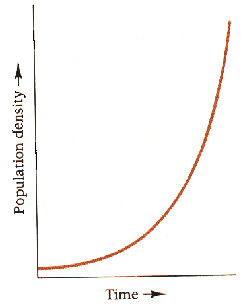 ------
------
 ------
------

 --------
--------
a. male/female ratio
b. age distribution / 3 at reproductive age
c. species density: effects health, food & H20 supply - territory needs
d. climate, availability of shelter, predator numbers, adaptability, means of protection
A) r-strategies: Reproductive strategy where the population puts more resources into producing as many offspring as possible in a short period of time. This reproductive strategy is common in unstable or rapidly changing environments. Examples: salmon (those that reproduce only once), protozoa, bacteria. Characteristics of this strategy include:
a) short life span
b) early maturity (they are capable of reproducing very quickly)
c) small body size
d) reproduce only once
e) many offspring produced per reproductive cycle.
B) k-strategies: Reproductive strategy where the population puts more resources into development and long-term survival of each individual. This reproductive strategy is common in stable, unchanging environments. Examples: whales, sharks, humans. Characteristics of this strategy include:
a) long life span
b) late maturity
c) large body size
d) reproducing many times over long periods of time.
e) one or two offspring per reproductive cycle
Random Sampling: Method to scientifically estimate population of individuals in an area using a grid. Count individuals in some grids, average, and multiply by total # of grids.
Mark-capture method: Capture & mark individuals. Release. Capture more individuals. Note how many marked individuals there are. Use Lincoln Index below.
Lincoln Population Index: A mathematical model for estimating population size when counting the whole population would be too difficult to do.
Population Size = (n1 X n2) / n3
where: n1 = # caught, marked, & released 1st time.
n2 = # captured 2nd time.
n3 = number of marked individuals caught 2nd time.
